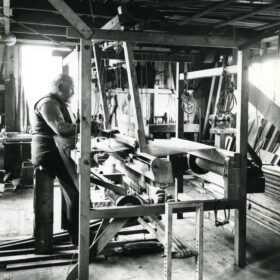
David Kirkness was born in Westray, Orkney, 1855 and died in Kirkwall, Orkney, 1936. In the 1870s he moved to Kirkwall where he set up a general joinery workshop, making traditional straw-backed Orkney chairs as a side-line. Twenty years later the Orkney chair had become the workshop’s main product. In May 1890, Kirkness was invited to submit two Orkney straw chairs to be part of the Scottish Home Industries Association display at the fifth Scottish International Exhibition in Edinburgh. The chairs generated widespread interest as their handcraftsmanship and vernacular design had a natural affinity with the Arts and Crafts movement. The traditional ‘straw chair’ became the fashionable ‘Orkney Chair’, gracing drawing rooms designed by Charles Rennie Mackintosh among others. A pair was even sent to King Edward VII. The aristocratic women who ran the Scottish Home Industries Association proved invaluable in marketing the Orkney chair. Driven by a desire to promote Scottish goods made in rural homes, they promoted it at British and foreign exhibitions. This led to increased sales to individuals and shops, including exports to South Africa, the Americas, India and Australia. The Orkney chair fitted into a romantic view of Scottishness at the turn of the century, and the idea that a well-crafted object could embody local or national identity. By 1909, retailers such as Liberty of London were ordering over 40 chairs a month. Four other Orkney workshops began making the chair, but none matched the success of David Kirkness. Over his lifetime Kirkness made a reported 14,000 chairs. The demand came from a fashionable clientele far removed from local Orkney families. After the Second World War, Reynold Eunson, a fellow Orcadian carpenter, bought the workshop and continued manufacturing the Orkney chair in the traditional manner. Kirkness should not be identified as an Arts and Crafts maker. He was not reviving a ‘lost’ tradition. Instead, the Orkney chair is a ‘vernacular’ object, its design, and even some of the tools used in manufacture, passed down from generation to generation of Orcadians. Kirkness’s innovation was to standardise the basic chair into four models: a gentleman’s, lady’s and child’s version of the standard chair, as well as a hooded version with box base. In doing so, he reflected contemporary Victorian social conventions but also simplified the making and marketing of his products.